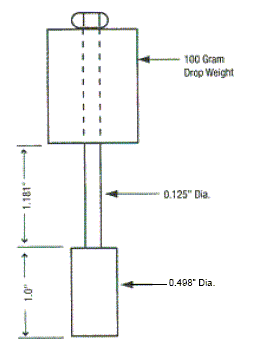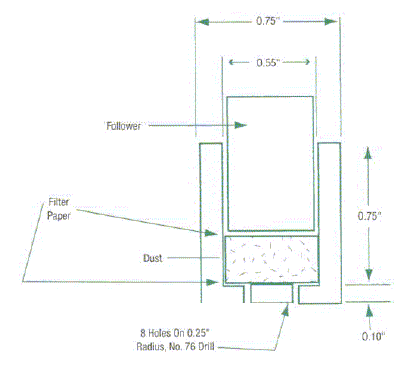106.3.2.73 TM-73, Volume of Voids in Compacted Filler or Fines
This method is from National Asphalt Pavement Association Information Series 127, Appendix A and determines the void volume in a dry-compacted mineral filler or fines (Rigden voids). The test method is based upon the assumption that the densest packing (maximum bulk density) of fines can be obtained by compacting the dry fines in a mold.
Contents
106.3.2.73.1 Applicable Documents
C 188 Specific Gravity of Hydraulic Cement
D 422 Particle Size Analysis of Soils
D 854 Specific Gravity of Soils
E 11 Specification for Wire-Cloth Sieves for Testing Purposes
106.3.2.73.2 Summary of Method
In this test method, the volume of the voids in a dry-compacted bed of mineral dust (Rigden voids) is determined by compacting the dust in a small mold.
106.3.2.73.3 Definitions
Maximum packing occurs when the particles are packed together in their minimum volume with a minimum void volume. Maximum packing results in a maximum bulk density.
Bulk density of the compacted fines is defined as the dry weight of the fines divided by the bulk volume of the compacted fines. The bulk volume includes the sum of the solid volume of the fines particles and the volume of the voids between the particles.
Density of the fines is defined as the dry weight of the fines divided by the solid volume of the fines particles. This density can be obtained from ASTM Test Method C 188 or D 854 or another appropriate test method.
106.3.2.73.4 Significance
The void volume in dry compacted fines (Rigden voids) is sensitive to changes in gradation and other properties of the fines, and, therefore, the dry compaction test has been proposed as a test for monitoring the uniformity of the fines collected in HMA facilities. Rigden voids can also be used to estimate the stiffening effect of the fines when mixed with asphalt cement.
106.3.2.73.5 Apparatus
106.3.2.73.5.1 Compaction Hammer
A compaction hammer, as shown in Fig. 106.3.2.73.5.1.1, is required to compact the fines into the test mold. The fines are compacted in one layer, using 25 blows of the hammer.
106.3.2.73.5.2 Test Mold
A test mold or sample holder, as shown in Fig. 106.3.2.73.5.1.2, is required for measuring the volume of the compacted bed of fines.
106.3.2.73.5.3 Compaction Pedestal
A steel block, 1 in. thick x 4 in. x 4 in. is used as a base for placing the test mold.
106.3.2.73.5.4 Thickness Measuring System
A dial gauge with 0.001 in. gradations is required for measuring the thickness of the compacted bed of fines.
106.3.2.73.5.5 Filter Membrane
Small, 1/2 in. diameter disks must be cut from Millipore No. SCWP0190R filter membrane. A round cutting tool can be used for this purpose.
106.3.2.73.5.6 Tweezers
Tweezers are needed for handling the filter disks.
106.3.2.73.5.7 No. 200 Sieve (75 μm)
A No. 200 (75 μm) sieve meeting the requirements of ASTM E 11 is needed to remove the particles larger than No. 200 (75 μm).
106.3.2.73.5.8 Balance or Scale
A balance or scale rated to 200 grams and sensitive to 0.01 gram is required.
106.3.2.73.6 Sample Preparation
The fines may be obtained from a primary or secondary dust collector, the coarse or fine aggregate, or the aggregate extracted from a mixture. Particles larger than No. 200 (75 μm) should be removed by sieving. Dry sieving is usually adequate if several sieves coarser than the No. 200 (75 μm) sieve are placed above the No. 200 (75 μm) sieve during the sieving operation to avoid overloading the No. 200 sieve (75 μm). Wet sieving should be avoided because the fine particles tend to stick together after they are dried.
106.3.2.73.7 Procedure
Use the cutting tool to cut a number of ½ in. diameter filter disks. Place two of these disks in the bottom of the sample cup, place the follower over the top of the disks, and seat the follower on the filter disks using firm finger pressure. Insert the entire assembly under the dial gauge. Record the dial gauge reading as t1.
Weigh the empty mold, two filter disks, and the follower, and record the weight as W1. Remove the follower and the two filter disks.
Place a filter disk in the bottom of the sample cup, making certain that it is centered and firmly in place at the bottom of the mold. Select a representative sample of minus No. 200 (75 μm) fines that weighs approximately 1.0-1.3 grams. Carefully place the fines in the sample cup over the top of the filter disk. Place a second filter disk over the top of the fines and use the follower and firm hand pressure to seat the disk on top of the fines. This procedure will result in some initial compaction of the fines and is to be expected.
Remove the follower, place the sample cup on the steel base plate and apply 25 blows with the compaction hammer. Use caution during the compaction process to be certain that the mold is seated firmly on the compaction pedestal, the drop weight falls its full height and the drop weight falls freely.
Remove the compaction hammer and insert the follower on top of the compacted fines and filter disk. Insert the entire assembly under the dial gauge and record the dial gauge reading. t2. Weigh the entire mold assembly and record as the weight W2.
The specific gravity of the fines solids is required to complete the calculations. If the specific gravity of the fines solids is not known, it will be necessary to measure it using ASTM procedure C 188 or D 854. Caution: The specific gravity of the fines solids may not be the same as for the other aggregate fractions. Although kerosene has been used as a liquid for determining specific gravity, water can also be used without adversely affecting the accuracy of the results.
106.3.2.73.8 Calculations
106.3.2.73.8.1 Notation
d = Diameter of test mold (in.)
Gfs = Specific gravity of the fines solids
t = Thickness of compacted sample (in.)
t1 = Initial dial gauge reading (in.)
t2 = Final dial gauge reading (in.)
VfB = Bulk volume of compacted fines sample (cm3)
Vfs = Volume of fines solids (cm3)
RV = Volume of voids in compacted fines or Rigden voids (cm3)
%RV = Volume of voids in compacted fines expressed as percentage of bulk volume
Wfs = Weight of dry fines solids (g)
γw = Density (unit weight) of water (1.00 g/cm3)
106.3.2.73.8.2 Compacted Dust
Calculate the bulk volume of the compacted fines VfB, in cm3, as follows:
- VfB = (15.7 x π x d2 x t) / 4
where:
- d = diameter of mold (in.)
- t = t2 –t1, sample thickness (in.)
Calculate the volume of the fines solids, Vfs, in cm3, as follows:
- Vfs = Wfs / (γ x Gfs)
where:
- Wfs = W2 –W1, weight of compacted fines (grams)
- γ = unit weight of water, 1.000g/cm3
- Gfs = specific gravity of fines solids as determined from the ASTM C 188 or D 854, or another suitable test method
Calculate the volume of the voids in compacted fines, RV (Rigden voids), as follows:
- RV = VfB - VfS
Calculate the percentage of voids in the compacted fines (Rigden voids) as follows:
- %RVfs = 100 x (VfB - Vfs) / VfB

